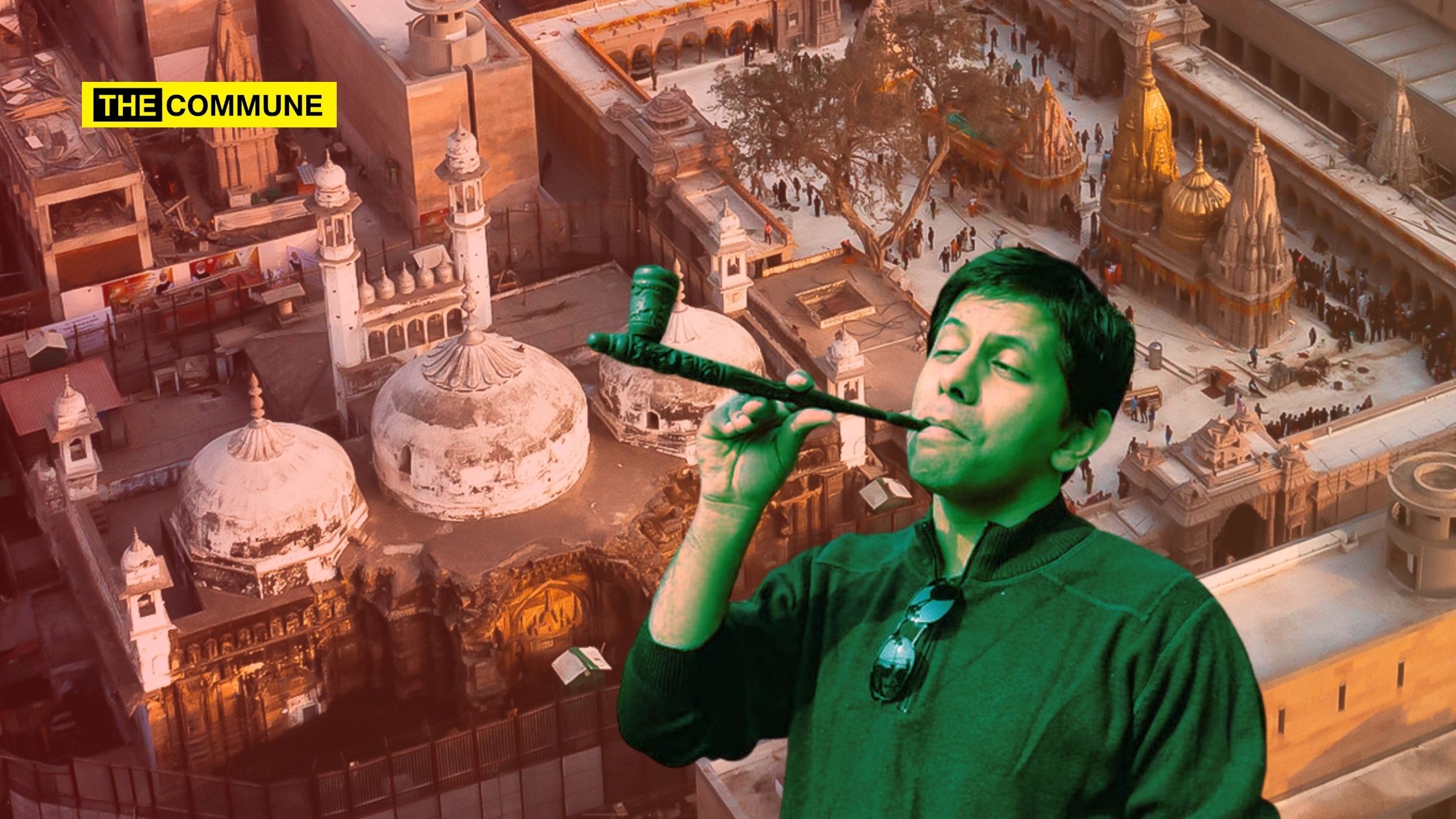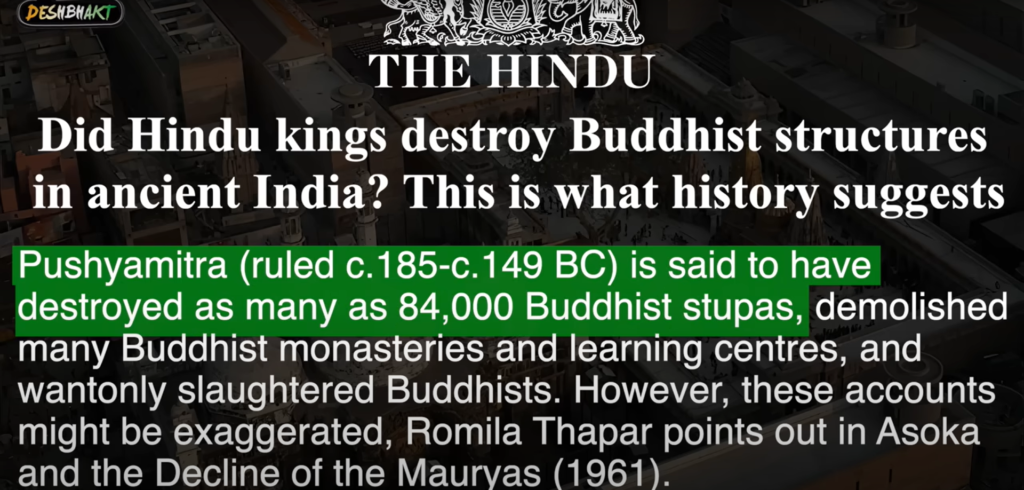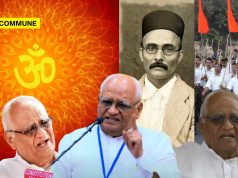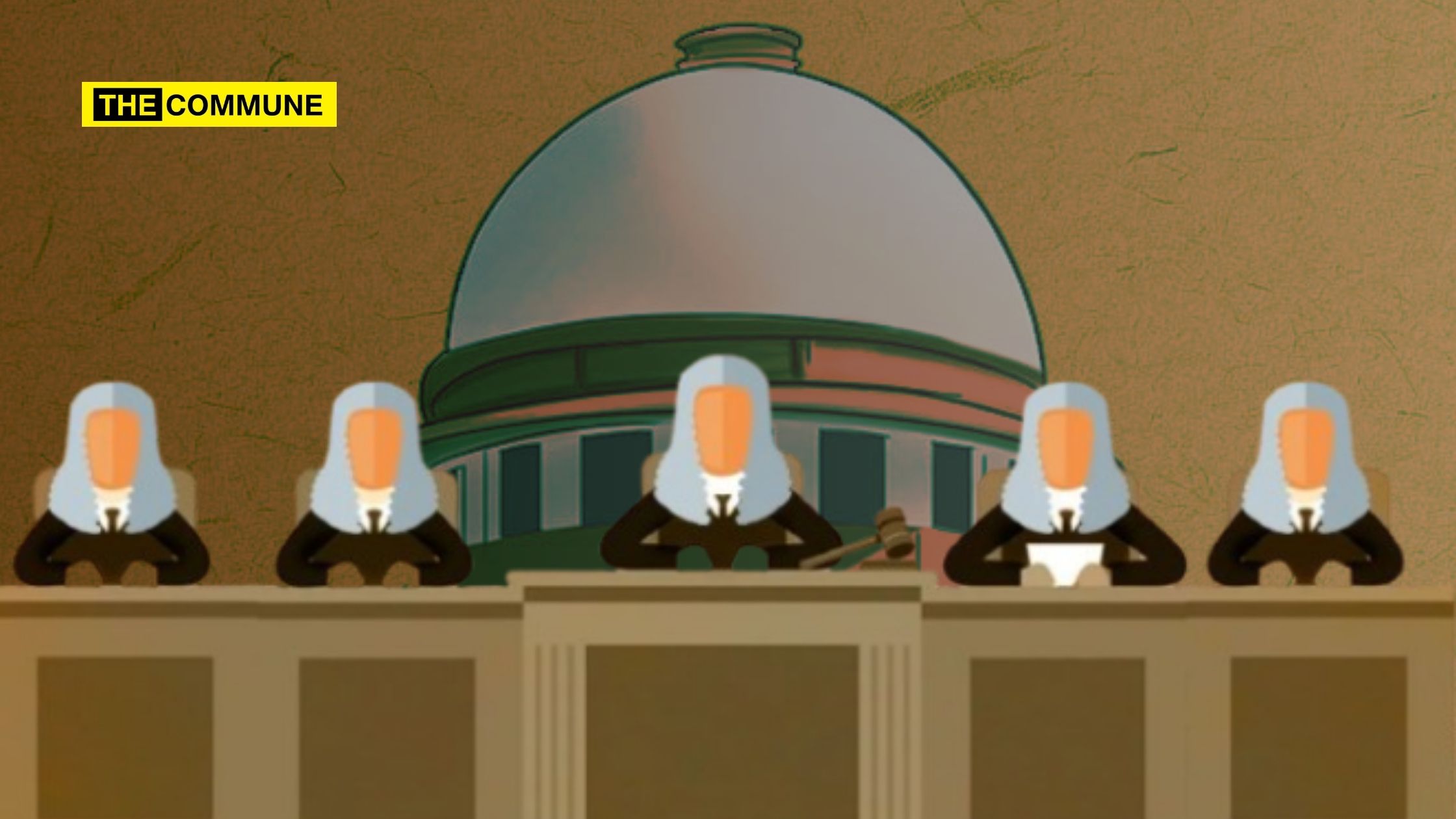
Leftist liberal historians tried their level best to bury the truth in the Ram Janmabhoomi case. Their propaganda fell flat as truth stared everyone in the face. They tried their level best to keep the communal tension simmering but Ram Lalla had to return to Ayodhya and we all know how things unfolded.
Now with the advent of social media, several self-proclaimed historians, and archaeologists have sprung up on YouTube. The leftists are making use of this platform well to further the unfinished agenda. Among these newly sprouted “historians” and “archaeologists” is a former comedian Akash Banerjee.
A clipping of a video on a YouTube channel named The Deshbhakt run by former comedian Akash Banerjee surfaced on social media platform X. In the clipping, he claims, “The history of Gyanvapi is complicated. People have different views about its history. There are several different researches also done on this. What was there before the mosque came to be? A lot of research has gone into that too. Was a temple already there before the mosque came into being? Or were there ruins of a temple? Or was that building that of Akbar’s Deen-e-Ilahi, a composite culture, was it a symbol of that, was it a structure of that composite culture?”
Meet top historian Akash Banerjee
ASI report found Hindu temple under Gyanvapi mosque in Varanasi
But Akash seems to think there was a "composite temple" of Akbar's unified Hindu-Muslim religion under the mosque
His source is some secretary of some Masjid Committee pic.twitter.com/h1IL0z1IFZ
— Abhishek (@AbhishBanerj) February 3, 2024
Upon checking out the full video, we come to realise that Banerjee’s video is made on assumptions about what he claims and places Hindu faith and beliefs (historical truth) as claims. He starts by establishing that the Kashi Vishwanath temple was “believed” to be built by Maharaja Vikramaditya. He also pulls in the Places of Worship Act and says you cannot mess with a structure. He says, “In 1991, Vijay Shankar Rastogi filed a suit in Varanasi district court on behalf of Kashi Vishwanath temple trust Claiming that 2050 years ago, there was a temple constructed by Maharaja Vikramaditya in place of Gyanvapi mosque today. And because there was already a temple there, the Places of Worship Act of 1991 is not applicable there. Now, what is the Places of Worship Act? In short, this is the act of the Parliament under which you cannot mess with any place of worship, religious character, and structure This act is a strong argument for the mosque side. So, as it is said in this petition of 1991, there was such a belief, among common people, among common citizens, there is a popular belief that Maharaja Vikramaditya had built the Kashi Vishwanath temple.”
He then begins his tirade about other beliefs as to how the temple was demolished. He says, “But there are different opinions on how the temple was demolished. Some say that the temple was demolished and a mosque was built instead. Others say that the mosque was next to the temple and no temple was demolished.”
He lists the following points:
- 12th-century Persian poet Hassan Nizami reported that General Qutubuddin Aibak of Muhammad Ghori defeated Jai Chandra, leading to the demolition of many temples in Varanasi.
- In 1296, during Iltutmish’s rule, Hindu businessmen rebuilt the temples in Varanasi after a demolition drive.
- Around the 13th century, another demolition drive occurred in Varanasi.
- During Akbar’s Mughal rule, Raja Todarmal and Raja Man Singh constructed the Kashi Vishwanath Temple.
- The controversial period of Aurangzeb saw large-scale temple demolitions.
- Maasir-I-‘Alamgiri, written by Saqi Mustad Khan, is considered an authentic source on Aurangzeb.
- According to Maasir-I-‘Alamgiri, after Aurangzeb’s orders, many temples, including Vishveshwar temple in Kashi, were demolished.
- Maasir-I-‘Alamgiri mentions Aurangzeb’s orders leading to temple demolitions in Tatta, Multan, and Kashi.
Akash claims that the temple side asserts that the Vishveshwar temple was demolished during Aurangzeb’s rule, and the Gyanvapi Mosque was built in its place. Now comes the leftist liberal caveat. He says, “Now there is no debate on this that during the rule of Aurangzeb, temples were destroyed and many mosques were built in their place. Is Gyanvapi one of those mosques or not?”
- According to Akash Banerjee, the Mosque side claims that the Gyanvapi has been present since the time of Akbar. He adds that the Secretary of Anjuman Intezamia Masjid Committee, Sayyed Mohd Yasin, claims Gyanvapi’s presence since Akbar’s time.
Akash goes on to explain what Dee-e-Ilahi means – “Deen-e-Ilahi was an experiment by Akbar to make a synthetic religion by combining good elements of all religions”. He adds that the Deen-e-Ilahi centre beside the mosque during Akbar’s time, was removed during Aurangzeb’s rule, with visible remains near the mosque, and many people consider this to be the remains of the temple.
Some other points he states include:
- Two graves near the mosque are cited as evidence that the place was a centre where all religions were allowed, not a temple, and that its architecture was also synthetic.
- After Aurangzeb’s death, the Mughal dynasty declined, and Maratha rulers, led by Queen Ahilyabai Holkar, rebuilt the Kashi Vishwanath temple in 1776.
Here’s How Does He Establish the Deen-E-Ilahi Nonsense
Displaying the picture of the Gyanvapi mosque structure, he says, “You can clearly see a structure on the side of the mosque. According to the mosque side, this structure is from the Deen-e-Ilahi centre from the times of Akbar. It is said that there are many Hindu deities’ and artifacts around it.”
Blames Hindu Organisations For Problems In the Case
He starts by explaining how Hindus and Muslims were “amicably” conducting the puja of the Shringar Gauri side. He says, “What is this about worshipping Shringar Gauri? Did Hindu devotees have daily access to it? The answer to this question is Yes, Hindu devotees were allowed to worship daily. Till 1993, worship of the gods and goddesses on the wall behind the mosque was done on a daily basis. No one had any problem. The Hindu and Muslim sides had no problem … as everyone was doing their own prayers.”
Here is where he starts blaming Hindu organisations for the change. He says, “But in this case, VHP leader Sohan Lal himself says that once some VHP and Bajrang Dal workers threw 300-400 pots of Ganga jal towards the Gyanvapi mosque. After which the administration placed a 10 ft barricade. VHP and Bajrang Dal did the same thing again, this time the administration put up a 20 ft barricade, as well as limited the access to Shringar Gauri to once a year. In 1998, Allahabad High Court took a big decision that for the next 22 years, stopped hearing about the dispute in the lower courts.”
Fails At Attempt To Establish Mosque’s Name
Banerjee first mentions Uttar Pradesh Chief Minister Yogi Adityanath’s statements on the meaning of the word Gyanvapi. He says, “How can a mosque be called Gyanvapi? Chief Minister Yogi ji has also commented on this. Gyanvapi means well of wisdom, reference of which can be easily found in 8th-century scriptures, in Skanda Puran.” Now comes the caveat. He adds, “In BHU, a professor of heritage study, Dr. Rana P.B. Singh, said that the mosque was initially called Alamgiri Mosque, but due to being located near the Gyanvapi area, it is now called Gyanvapi Mosque. And this became its name.”
And that’s how leftist liberals establish that the temple never existed!
In fact, upon checking the video where Prof Rana Singh talks about this, he says it is not known when the name Gyanvapi got attached to what was originally the Alamgir Mosque. The locality is called Gyanvapi and over time it came to be known so and that the mosque and the temple are attached by a wall, so they are not different. The mosque is built on the pillars of the temple. In fact, Prof Singh also adds that one can suppress history and the truth but cannot change it.
So Banerjee’s propaganda falls flat. The full video can be watched here:
Now how does he “bust” the Nandiji’s direction point? Here’s what he says, “Many people argue that Nandi’s face is in the direction of the mosque. According to Hindu belief, it is generally seen that the direction in which Nandi’s face is, is the direction of Shivaling. And in the Kashi Vishwanath Complex, one side claims that Nandi’s face is pointing in the direction of Gyanvapi mosque But on this claim, Dr. Rana P.B. Singh says that Nandi was donated to the temple by the king of Nepal in 1824. This claim does not stand.”
This surely does not answer why the Nandi is facing a direction completely opposite to the present Kashi Vishwanath temple. Gift or no gift, the direction of Nandiji is always facing his master, Lord Shiva.
Stresses On Places Of Worship Act
Next Banerjee goes on to establish why the Places of Worship Act came into being, why it is so important, and that nothing can be done to it.
He says that in 1984, VHP organised a Dharma Sansad, initiating the Ram Mandir movement, and that similar events occurred in Udupi in 1985, addressing demands related to Krishna Janmasthan and vacating the Kashi Vishwanath temple complex.
The Ram Mandir movement heightened communal tensions in the country during the 1990s. In 1991, the PV Narasimha Rao government passed the Places of Worship Act to prevent new controversies and maintain control over the situation. The Act was deemed “crucial” during the peak of the Ram Mandir movement, led by Advani’s rath yatra and increased communal tension due to shootings in Uttar Pradesh.
Knowingly or unknowingly, Banerjee acknowledges that the Mughals did demolish temples. He says, “As per this act, any place of worship as it existed on 15 Aug 1947, cannot be interfered with; whether it is a temple, a mosque, a church or a Gurudwara. Because if you sit and search, if you dig into history, you will find many such cases of how Mughals built mosques after demolishing temples.”
But he also slips in the propaganda that “Research also shows that the kings built temples on Buddhist structures.” He, however, fails to mention that these accounts could be exaggerated as mentioned in the same screenshot:

“Pushyamitra (ruled c.185-c.149 BC) is said to have destroyed as many as 84,000 Buddhist stupas, demolished many Buddhist monasteries and learning centres, and wantonly slaughtered Buddhists. However, these accounts might be exaggerated, Romila Thapar points out in Asoka and the Decline of the Mauryas (1961).”
Towards the end, he also tries to instill fear among his viewers by saying this will be a never-ending issue if we continue looking for temples under mosques. He says, “How many temples were destroyed, how many mosques were built, if we start to follow up on this, this will continue for the next 700 years. Let’s assume that the ASI survey proves that there are some religious and temple remains under the mosque. Still, you cannot change the existing mosque and its character according to the law of 1991. Then, if we talk about the Supreme Court and according to its order, the government should clear its stand by 31st October, then what will be the take of the central government in this matter? If the Modi government repeals this act or tries to do so, then the issues of Kashi and Mathura will again start surfacing. And along with that, I don’t know how many more such demands will come up. So, all this time and effort will go only into this. But it is possible that the government which loves bulldozers, thinks that the Places of Worship Act can also be removed. Organizations like VHP and Bajrang Dal keep on saying that Kashi Mathura Baaki Hai. Will the government be able to handle these organizations after the repeal of this act? Will we have to face the extreme communal environment like in the early 90s again? The act was made to tackle exactly this. Whatever the court’s decision is will be final. But when will we talk about the real issues? China’s threat, unemployment, inflation, law and order.”
Leftist liberals are so short-sighted that they fail to realise that in the era of social media and high-speed internet, any propaganda will go bust because resources are just a search away. For people like Akash Banerjee who thrive on spreading divisive agenda of the leftist historians, please remember, Ayodhya To Bas Jhanki Hai, Kashi Mathura Baaki Hai!
Hydra is a freelance columnist.
Subscribe to our channels on Telegram, WhatsApp, and Instagram and get the best stories of the day delivered to you personally.




